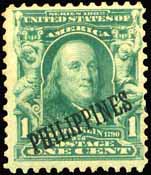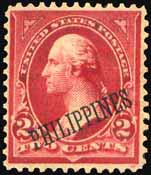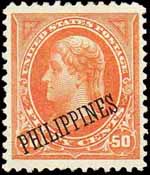| When the Spanish surrendered in Manila, the United States established
a branch of the San Francisco Post Office in the existing Spanish Post
Office. United States stamps, the regular 1894-95 and 1898 issues in stock
and some of the Colombian and Trans-Mississippi issues, were placed on
sale on July 16, 1898.
As the supply of United States stamps were used, additional stock was
ordered. The replacement stamps were overprinted "PHILIPPINES" and first
went on sale on June 30,1899, the sale of stamps without the overprint
was discontinued at the same time. Both regular and overprinted stamps
were valid for postage in the Philippines as well as in the United States
until October 1,1903.
  
Fig. 1.1: Genuine Black "PHILIPPINES" Overprint
The genuine overprint is FLAT BLACK, not shinny or dull, in UPPER CASE
letters with SERIFS. The length of the overprint is 15.5 mm and the height
is 2.75 mm and rises from left to right at an angle of 22 degrees from
the horizontal plane.
During the latter part of the 18th century and the early 19th century,
stamp collecting was the hobby of the aristocracy in Europe. Some of the
wealthy collectors there, including royalty, would go to any length to
amass the most prestigious collection, and there were some who found ways
to accommodate them.
The United States Post Office did not release very much information
on the stamps being used in the Philippines, only that they had overprinted
stock on hand from current issues. When the second issue was put on sale
on September 20, 1903 many collectors began trying to obtain the first
issue, and it was not readily available. The first Forgeries of the overprints
came from Switzerland with some known earlier than 1908. Because of the
lack of information about the overprints and of the stamps they was applied
on, the Switzerland overprints are found on stamps which were not genuinely
overprinted and forged overprint is not within specification.
After the Philippine-American War ended, the Post Office Department
decided to terminate the overprinting of stamps with "PHILIPPINES" and
discontinued their use on September 8,1906. The remainders, except for
some Postage Due Stamps, were destroyed on February 13 and 14,1907.
With an accurate listing of the stamps issued with "PHILIPPINES" overprint
by Gen. H.H.Bandholtz, recorded at the time of destruction, Many men who
had served in the Philippines and had obtained some stamps, tried to complete
their collections. To meet this demand, another group of forgeries known
as the "New York" forgeries, from their place of manufacture, were supplied.
These forgeries are much more dangerous as they are on the correct stamp
and the overprint is close to the genuine one.
     
|

